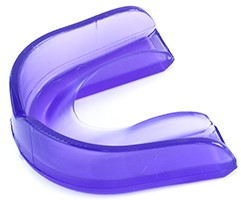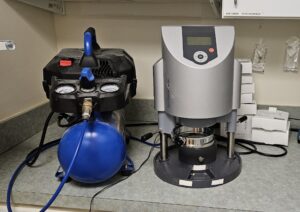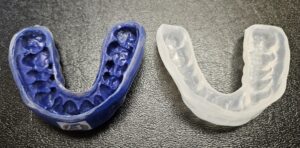
Dr. Nick Calcaterra is the Team Dentist for the Bridgeport Islanders. He’s made hundreds of mouthguards for athletes in all sports.
Custom Mouthguards (also referred to as Sports Guards or Athletic Mouth Protectors) are individually fabricated dental appliances designed to protect an athlete’s teeth and soft tissue from injury during sporting activities. The mouthguards are made specifically for an athlete’s unique teeth and gum structure.
As the Team Dentist for the Bridgeport Islanders Hockey Team and expert in Sports Dentistry, Dr. Nick Calcaterra is exceptionally skilled in the design and fabrication of custom mouthguards for athletes at all skill levels. He is proud to state that there are dozens of active and former NHL and AHL players on the ice in the U.S., Canada, and Russia wearing sports guards that he personally fabricated in our office in Orange, CT.
As experts in protecting athletes, we are proud to present detailed information on the various sports guards available. Please note: this is a fairly long page, with information written exclusively by Dr. Nicholas Calcaterra, who is an expert on this subject.
Benefits of Custom Mouthguards
Athletes should consider (and in many sports are required to wear) a custom mouthguard while participating in their respective sporting activities. Some of the many benefits are listed below:
- Protection of the teeth, gums, and underlying jaw bone.
- Protection of the soft tissues of the mouth including the lips, cheeks, and tongue.
- Can improve the athlete’s performance – with such a precise fit, the athlete is focusing less on the guard, and focusing more on his/her performance.
- Possible reduction in the risks of concussions. Note: there is conflicting evidence around this hypothesis, but a 2014 peer reviewed study did support this claim.
- Compliance with many requirements from athletics associations – such as the National Federation of State High School Associations – and the NCAA (this is good link to a free copy of the NCAA Sports Medicine Handbook – go to page 111).
These are just some of the benefits. But note that these benefits are for custom mouthguards – not stock ones. See below for more information on the types.
Types of Mouthguards
There are several types of mouthguards available. The decision on which type is dependent upon many factors. Those factors generally include the age of the athlete, potential plans for future orthodontics, the nature of the sport, the level of competition, a history/ies of previous injuries, and many other factors.

A stock mouthguard. Some protection is better than none. But this type is far from ideal.
Based on the above, you (or your dentist) can make recommendations as to which type. Please note that as the athlete gets older, he/she may transition from a less expensive one to a more expensive one.
- Stock – these are exactly what the name implies. They are purchased at a sporting goods store and are basically a one-size-fits-all. You take it out of the box and start to wear it. They are generally inexpensive.
- Boil and Bite – these also are purchased at sporting goods stores. You place the guard in hot water to soften the material and then mold it to the teeth. This gives a slightly better fit than stock ones. These are slightly more expensive than stock mouthguards, but much less costly than Vacuum or Pressure Formed (see types 5 and 6 below).
- “Online” Custom – there are many options available, too many to list, as the online companies seem to come and then disappear within months. But with these types, some type of impression is done at home by the athlete. He/she mails the impression to the company, who then custom makes a mouthguard. These are generally more accurate and better protection than Stock and Boil and Bite. However, without a dentist overseeing the fabrication, there can be issues related to the fit and/or bite and/or size that are not detected by the athlete.
- Dentist Fabricated 3D Printed – 3D printing for dentistry is relatively new and ever changing. As of Fall 2024, there are some options available (as per the vendors selling the products), but they have yet to be proven nor endorsed by the Academy for Sports Dentistry. As such, we cannot offer much commentary on them, and we do not offer them.
- Custom Vacuum Formed – these guards are fabricated by your dentist using a model created from a custom mold or scan of your mouth. Once the mold is complete, a relatively inexpensive vacuum machine (this is an example) creates the custom mouthguard using heat and suction. The “suction” or “vacuum” literally pulls the hot plastic onto the model, creating a very close fit. The dentist will then adjust this to the athlete’s bite and ensure that it is comfortable. Note: generally speaking, this is the style we recommend for most casual athletes ages 12 – 18 who do not intend to participate at the collegiate level.
- Custom Pressure Laminated – these are considered the gold standard and are the best solution out there – hands down. Just like a custom vacuum formed guard, a model of your mouth is made from either an impression or digital scan. Then, using a sophisticated high pressure machine connected to an air compressor, a special piece of plastic is heated up, and then under extreme pressure, that hot plastic is molded around the model. The result is a guard with perfect fit and comfort. See below for more details.
Why Pressure Laminated Mouthguards are the Best Protection
We often get the question: Why is this style the best protection?
Or we get the question: Can I get the same type of guard you make for the Bridgeport Islanders players?

Our Drufomat Pressure Lamination Machine and air compressor in our lab. Very few dentists have invested in this technology. If you want the best sportsguard available, you need to use this machine.
The pressure lamination technique gives you – the athlete – the very best protection – for several reasons:
- Precise Adaptation – high heat and high pressure (up to nearly 85 psi) will allow for the mouthguard material to adapt to your model of your teeth/gums with incredible precision. This allows for a better fit – which leads to greater comfort and protection.
- Negligible Deformation – because the material is molded under such high heat and pressure, there is little to no tendency for the material to relapse and “revert back” to the original shape. Vacuum formed guards and boil and bite ones will, over time, lose their custom fit, causing the guard to be less comfortable and/or possibly fall out.
- Ability to Add Layer(s) – it should make complete sense that – if the mouthguard material is thick – it will not adapt as readily to the model of your mouth. We use a material that starts out at 3 mm. But upon fabrication, the material thins out, and does not give ideal thickness in certain areas. A pressure lamination machine allows you to add additional layers. This is in contrast to other techniques, which is basically a “one size fits all” approach.
- Ability to Thicken Certain Areas – every sport is different. In basketball, you are very likely to take a direct hit to the front of the teeth – thus the need for the front portion to be thicker. In football, you will not experience a direct hit to the front of the the teeth, but you could take a direct hit to the base of your chin, causing your upper and lower jaws to slam together. For those athletes, we are able to thicken the biting surface material, while keeping the edges thinner. This is only possible with pressure lamination.
- Different Colors, Logos – while this has little to do with comfort and protection, pressure lamination allows you to incorporate team logos and/or color combinations into the guard.
Below is an interesting photo:

The blue guard on the left was fabricated by us using our Drufomat Pressure Lamination machine. Notice the incredible detail on the chewing surfaces of the teeth (you can even tell if the athlete had a filling or two). This is a two layer guard and has the old Bridgeport Islanders logo on it. On the right is a guard made using the vacuum forming machine. It is not as thick and does not have the incredible fit/adaptation that the blue one does. Click on the photo to see it in great detail.
The above photo and caption shows you the difference between the two custom mouthguards.
Final Thoughts on Sports Guards
We’d like to summarize our thoughts:
- For young athletes just beginning their respective sports, we do recommend a boil and bite guard. A 9 year old hockey player with a full cage on his/her helmet typically doesn’t need more protection than this.
- For casual teenage and high school athletes, we recommend a vacuum formed custom mouthguard. Note that there are a lot of factors that go into this decision, many of which were highlighted already.
- For teenage athletes intending to participate in college sports, collegiate level (all divisions), and professional athletes, we recommend the custom pressure laminated guard. These meet all the criteria and requirements as set forth by the Academy of Sports Dentistry and most of the various sports organizations (NCAA, etc.)
 As always, you can scheduled a consultation with Dr. Nick Calcaterra to discuss your specific needs in great detail. From there, he can recommend the best sportsguard based on his extensive experience.
As always, you can scheduled a consultation with Dr. Nick Calcaterra to discuss your specific needs in great detail. From there, he can recommend the best sportsguard based on his extensive experience.
